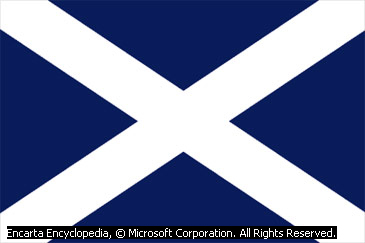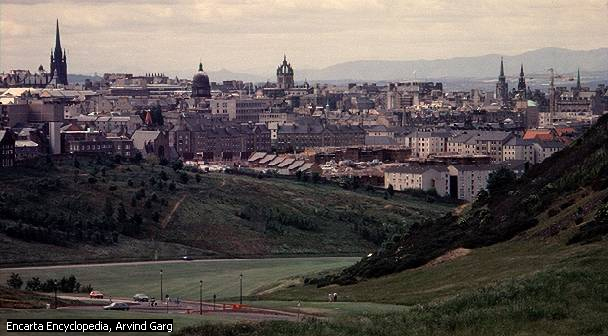|

Scotland, one of the four national
units that make up the United Kingdom of Great Britain and
Northern Ireland. The other units are England, Northern Ireland,
and Wales. Edinburgh is the capital of Scotland, and Glasgow is
its largest city.
Scotland and its offshore islands comprise the northernmost part
of the United Kingdom. The Scottish mainland, which occupies
roughly the northern third of the island of Great Britain, is
bordered on three sides by seas. To the north and west is the
Atlantic Ocean; to the east is the North Sea. Rugged uplands
separate Scotland from England to the south.
The
territory of Scotland includes 186 nearby islands, a majority of
which are contained in three groups. These are the Hebrides,
also known as the Western Isles, located off the western coast;
the Orkney Islands, located off the northeastern coast; and the
Shetland Islands, located northeast of the Orkney Islands. The
largest of the other islands is the Island of Arran.
The total
land area of Scotland, including the islands, is 78,790 sq km
(30,420 sq mi).
An independent nation for much of its history, Scotland was
joined to England by a series of dynastic and political unions
in the 17th and 18th centuries. Scotland retains a separate
national identity, however, supported by separate legal and
educational systems, a national church, a parliament with
wide-ranging powers, and other national symbols and
institutions.
The capital of
Scotland
Edinburgh, city, capital of
Scotland, on the southern shore of the Firth of Forth. Edinburgh
is the second largest city in Scotland, after the industrial
center of Glasgow. It is, however, Scotland's financial,
cultural, educational, and service-industry hub. Among the
city's manufactures are paper, whisky, electrical and electronic equipment, food
products, and chemicals. The printing and publishing industry
was well established here by the 16th century. Edinburgh's port,
at the communities of Leith and Granton, is a major service
point for vessels associated with the North Sea petroleum
industry. The principal imports are petroleum products, grain,
ores, and wood; exports include whisky, steel, and fertilizer.
The city is also one of Britain’s major tourist centers.
are paper, whisky, electrical and electronic equipment, food
products, and chemicals. The printing and publishing industry
was well established here by the 16th century. Edinburgh's port,
at the communities of Leith and Granton, is a major service
point for vessels associated with the North Sea petroleum
industry. The principal imports are petroleum products, grain,
ores, and wood; exports include whisky, steel, and fertilizer.
The city is also one of Britain’s major tourist centers.
Edinburgh's central
dominating landmark is Edinburgh Castle, rising on sheer cliffs
above the city. Located here is the 11th-century Chapel of Saint
Margaret, the city's oldest structure. The Castle Rock is
connected to the 16th-century royal Scottish residence of
Holyrood Palace by a road known as the Royal Mile, the main
thoroughfare of the Old Town district of the city. Other notable
buildings in Old Town include Saint Giles, the National Church
of Scotland (largely 15th century); the Parliament House, seat
of the Scottish Parliament from its completion in 1639 until
1707; and the house of the 16th-century Protestant reformer John
Knox. To the north of this district is New Town, which was
developed in the late 18th century and contains many fine
buildings designed by the Scottish architect Robert Adam.
Separating the two districts is Princes Street Gardens,
occupying the bed of a loch that was drained in 1816.
Among Edinburgh's
cultural institutions are the National Gallery of Scotland
(1859), the Scottish National Portrait Gallery (1882), the Royal
Scottish Museum (1854), and museums of modern art and Scottish
history. The Edinburgh International Festival, held here
annually since 1947, is a world-renowned arts festival. The
University of Edinburgh (1583) is especially noted for its
schools of medicine and law. Other educational institutions
include Heriot-Watt University (1821), Edinburgh College of Art
(1907), and colleges of architecture, technology, education, and
theology.
Castle Rock was
occupied by the Picts about the 6th century
ad. In the 11th
century Malcolm III, king of Scotland, had his castle here, and
his wife, Saint Margaret, built a small church. King Robert
Bruce granted Edinburgh a charter in 1329. In 1437 the town
became the national capital following the murder of King James I
at Perth, the former capital. Edinburgh lost much of its
commercial and administrative importance in 1603 when James VI
became James I, king of England, and departed for London. By the
Act of Union with England in 1707, the Scottish Parliament was
dissolved and Scotland was governed by the British Parliament.
Edinburgh's expansion
beyond its medieval boundaries to New Town was planned by the
town council in 1767. During the 18th and 19th centuries the
city flourished as a cultural center. It was the home of writers
Robert Burns, James Boswell, and Sir Walter Scott and the
philosophers Adam Smith and David Hume. The city's boundaries
were expanded considerably in 1856 (when New Town was absorbed),
1900, and 1920. Before 1975 Edinburgh was the county town of the
former county of Midlothian. In the 1996 reorganization of local
government, the City of Edinburgh became a unitary authority.
Population (2001 estimate) 449,000.
Microsoft ® Encarta ® 2006.
© 1993-2005 Microsoft Corporation. All rights reserved.
For other
informations about Scotland,see the info panel.
|